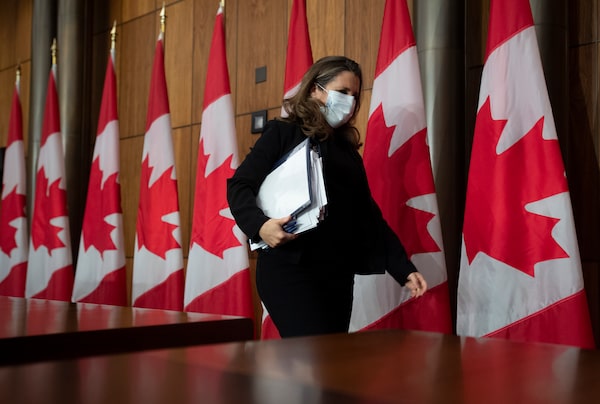
Deputy Prime Minister and Minister of Finance Chrystia Freeland leaves a news conference held before presenting the Fiscal update in the House of Commons in Ottawa on Nov. 30, 2020.Adrian Wyld/The Canadian Press
Finance Minister Chrystia Freeland sat down with Canada’s leading economists last week to canvass their ideas on how to spend the $70-billion to $100-billion of stimulus spending that Ottawa has promised to aid the postpandemic recovery over the next three years. Their advice, frankly, was that we might not need that much stimulation.
Ms. Freeland held a videoconference last Wednesday for the traditional prebudget consultation meeting with senior private-sector economists. The stimulus package, proposed by the government in its fall economic statement last November, was at the centre of the conversation.
But many of those economic experts envision a stimulus plan – focused on awakening business investment and enhancing the country’s productivity – that would return the economy to full speed well before then. They’d like Ms. Freeland to be prepared to turn off the taps once the economic indicators say so, whether all those billions of stimulus dollars have been pumped through the hose or not.
“Medium term, [we need to] right-size government spending,” said Craig Wright, chief economist at Royal Bank of Canada, who took part in the discussions.
Over the past few months, economic forecasts have generally crept upward, bolstered by the arrival of vaccines, a massive U.S. stimulus package and evidence that the economy has been weathering the second wave of the pandemic better than many had feared.
Canada’s big-bank economists now forecast that after a contraction of about 5.4 per cent in 2020, we’re headed for a rebound of nearly 5 per cent in 2021. That would put us on track to return to pre-COVID levels of output some time in 2022; and, you might recall, the economy was running relatively close to full capacity before the pandemic arrived.
That pace of recovery certainly assumes a substantial helping hand from fiscal stimulus. Nevertheless, it suggests that a plan to continue that massive level of government spending for three years – which would take us out to the spring of 2024 – might be at least a year and a half too much.
“The economy is actually very well prepared to rebound when the health concerns recede,” Bank of Montreal chief economist Doug Porter said. “We don’t believe the economy will need a whole lot of prodding by policy to get going.”
The danger, they warn, is that too much government spending beyond when it’s needed will contribute to overheating the economy, pushing inflation and interest rates higher. It would also force the private sector to compete with government for increasingly scarce resources – effectively discouraging the business investment that the economy will ultimately need for healthy postpandemic growth.
No one wants the government to pull the plug on fiscal stimulus too soon – a lesson that was learned after the 2008-09 global financial crisis, and the slow, painful recovery that followed. Nevertheless, the economists emphasized that Ottawa should commit to clear, objective economic measures – along the lines of the labour-market indicators that Ms. Freeland identified in last November’s economic update as providing “fiscal guardrails” – to determine when to shut off the spending taps.
In the meantime, business investment is one key area at which the economists urged Ms. Freeland to direct the stimulus nozzle. The stimulus for the consumer side is already in place; the abundant income supports over the past 11 months, together with the pandemic restrictions, have resulted in a boom in household savings that is waiting to be unleashed. Entrepreneurs and corporate managers will need more support and incentives to overcome their understandable skittishness, as they emerge from a period of profound and still-considerable uncertainty.
Jean-François Perrault, chief economist at Bank of Nova Scotia, said he suggested to Ms. Freeland that the government should temporarily subsidize business investment, perhaps through a matching grant where Ottawa would contribute a percentage of capital spending over, say, the next year or 18 months.
“You dramatically reduce the cost of capital; you basically put a sale on capital,” he said.
“I said to her, ‘Effectively, what you’ve done over the last year is subsidize labour, at the expense of capital. So of course firms haven’t been investing,’ ” he said. “At some point, that creates an issue in terms of sustainability of growth.”
The economists also urged Ms. Freeland to focus on enhancing productivity in the economy, which would effectively increase the country’s capacity for growth. There was support in the discussions for spending on infrastructure, and for improved access to child care.
As is typical in these meetings, the economists did most of the talking, while Ms. Freeland mostly listened, keeping her budget cards close to her vest. Nevertheless, by all accounts, the rookie Finance Minister acquitted herself well in her first prebudget consultation with economists. Participants described her as well prepared and knowledgeable, and seemed more receptive to their ideas than some past finance ministers – including her predecessor, Bill Morneau.
“She’s very engaging, and very engaged in the topic. She’s obviously read all of our research. I don’t know where she has the bandwidth to do it,” Mr. Wright said.
Your time is valuable. Have the Top Business Headlines newsletter conveniently delivered to your inbox in the morning or evening. Sign up today.
 David Parkinson
David Parkinson